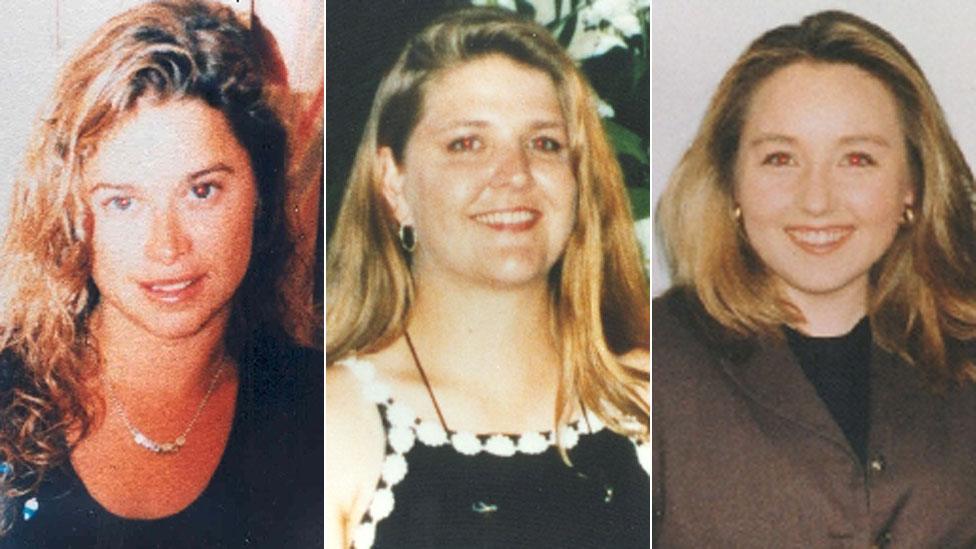Claremont killings: Australian man guilty of two 1990s murders
- Published

(L-R) Ciara Glennon, Jane Rimmer and Sarah Spiers disappeared on separate nights in 1996 and 1997
An Australian man has been found guilty of murdering two women in separate abductions in the 1990s, but not guilty over the killing of a third woman.
The case has been one of Australia's highest-profile mysteries for more than two decades, and came to be known as the Claremont serial killings.
Bradley Robert Edwards, 51, denied killing Jane Rimmer, 23, Ciara Glennon, 27, and Sarah Spiers, 18, in Perth.
On Thursday, a judge convicted him of Ms Rimmer and Ms Glennon's deaths.
But Justice Stephen Hall said there was not enough evidence to convict him of murdering Ms Spiers.
The judge-only trial was Western Australia's longest-running and most expensive murder trial, taking place over seven months and involving over 200 witnesses.
"Every Western Australian is thinking of the families of Sarah, Jane and Ciara today," state Premier Mark McGowan said after the verdict.
"What happened to these young women changed our state."
Nightlife abductions
The women disappeared on separate nights in 1996 and 1997, from a popular nightlight spot in Claremont, a Perth suburb.
In the case of Ms Rimmer and Ms Glennon, Justice Hall said Edwards took them from the street, drove them to the city's outskirts and used a knife or other sharp object to attack them.

Bradley Robert Edwards was arrested in 2016
In both cases the victims had defensive wounds, showing they tried to fight back against the telephone technician. Both were fatally wounded in the neck before Edwards hid their bodies in the bush, the court heard.
They were discovered a few weeks after their disappearances. But Ms Spiers, the first to go missing in 1996, was never found.
It remains unclear how Edwards trapped the women. Prosecutors said he either abducted them or lured them into his work car, which looked like a taxi.
Breakthrough
Over the next two decades, more than 700 police officers worked on the case.
In 2016, Edwards was charged with two of the murders and assaults of other women. Two years later, he was charged with killing Ms Spiers.
Detectives managed to match his DNA to a fragment found under Ms Glennon's fingernail. Prosecutors said material fibres found on the bodies of Ms Glennon and Ms Rimmer had also come from Edwards' clothing and car.
Before his trial began last year, Edwards also admitted to the rape and assault of two other women, in 1988 and 1995.
Prosecutors argued this pattern of behaviour showed he was the Claremont killer.

The cases has been closely followed in Australia
However, Justice Hall said circumstantial evidence was not enough for a conviction on the final charge.
"The propensity evidence makes it more likely that the accused was the killer of Sarah Spiers, but it cannot proved beyond reasonable doubt in the absence of any other evidence as to the identity of her killer," he told the Supreme Court of Western Australia.
Speaking after the verdict, Western Australian authorities urged Edwards to reveal Ms Spiers' location.
"Can you please tell us. Can you please provide some closure to the Spiers family," Mr McGowan said.
Police commissioner Chris Dawson praised "the strength and resilience" of the victims' relatives, many of whom were in the courtroom on Thursday.
"Three innocent young women were killed, along with the hopes and dreams they never got to fulfil," Cr Dawson said.
"Bradley Edwards can now be called for what he is: a brutal rapist and a murderer."
He will be sentenced on 23 December.